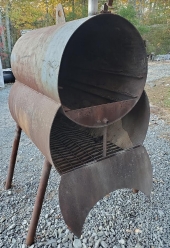









"It is a miracle that curiosity survives formal education." -- Albert Einstein








"It is a miracle that curiosity survives formal education." -- Albert Einstein








 . You should also consider having a small damper vent on the fire door for draft options and to keep an eye on the fire without opening the door.
. You should also consider having a small damper vent on the fire door for draft options and to keep an eye on the fire without opening the door.
"It is a miracle that curiosity survives formal education." -- Albert Einstein




Chris Burge wrote:Graham,
I'm sure a lot of time was spent on hand fabricating the flue, but let me ask you this:
If you were walking down a road and met someone coming the other way who stops to tell you, "Hey, look out! If you follow this road, you'll fall off the cliff up ahead! You should turn around and go back--there's a much better way to go if you take a different route", would your answer be, "Well, I've walked all this way down this road, I'd rather just head towards the cliff"?
Commercially available wood furnaces that are comparable to your design have a 40% smaller firebox (18"x24"x36") with an 8" flue.
Because of the burn dynamics of your device, and the size of the fire that you are trying to contain, I steadfastly recommend that you re-fab the flue to 10". That gives you the ability to put an 8x8" door on the lower half of the front panel and a small damper vent on the face of your ash drawer. Putting a vent on your ash drawer is key as this will not only give you draft up through your fire, instead of across the top of it, but it will also allow more of the coals that fall into the drawer to burn completely. The cardinal rule will be: always close the ash vent before opening the fire door to prevent the possibility of smokeback-- but with a 10" flue, you might not have that problem. You should also consider having a small damper vent on the fire door for draft options and to keep an eye on the fire without opening the door.

|
Morning came much too soon and it brought along a friend named Margarita Hangover, and a tiny ad.
The new kickstarter is now live!
https://www.kickstarter.com/projects/paulwheaton/garden-cards
|







